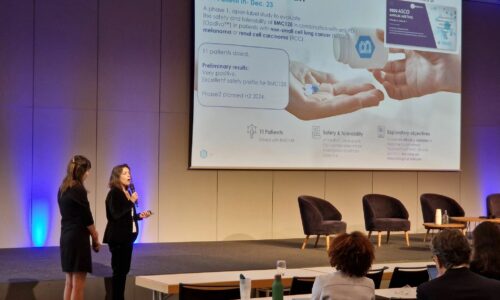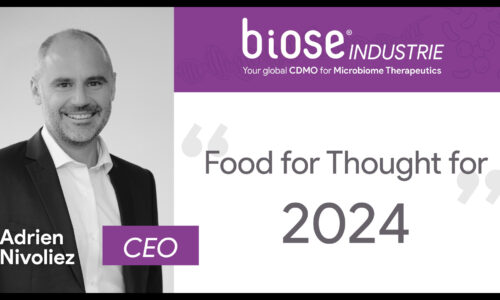Introduction
Last month, Biose industrie had the privilege of speaking at Microbiome Connect: Asia. The two-day congress took place in Seoul, Korea, and was attended by microbiome enthusiasts across academia and industry alike. Given the rapidly growing APAC microbiome market, Biose were thrilled to hear from APAC voices on topics ranging from regulatory firsts to clinical updates.
Day One
The opening panel, “New Frontiers in Microbiome Therapeutics” discussed avenues for collaboration between the APAC and global market. Genome & Company’s CEO, Jisoo Pae, joined the CEOs of BiomMe, Sang Sun Yoon, and GwangPyo Ko, KoBioLabs, to engage in a thought-provoking conversation covering national government initiatives across APAC countries, and the future of microbiome therapeutics research. Korea was identified as an “easier” territory to develop microbiome therapeutics within due to the regulatory leniency. The discussion also touched upon the importance of engaging with a CDMO in the early stages of drug development, loss of therapeutic efficacy of combined bacterial strains, and the importance of selecting the right target disease candidate. On the latter point, the cancer market was highlighted as being a promising target for LBP development.
The morning of day one placed regulatory considerations at centre-stage. Servatus’ Samantha Coulson, head of clinical research, explained the company’s platform and proceeded to discuss regulatory differences between LBP and probiotics. The key differences being, LBPs are approved by regulatory authorities based on clinical trials whereas probiotics are treated like food supplements. The intended use of the product was also cited as a clear differentiator, with LBPs having intended therapeutic use in a patient population. Coulson also highlighted the safety considerations of bacterial products, stating translocation of LBPs across mucosal barriers are an important risk associated with the modality. This led onto BiomeBank’s presentation regarding their world first authorisation for a donor-derived microbiome-based product. Mirjana Rapaic, Head of regulatory affairs, provided a vibrant talk on Biomebank’s journey to market authorisation, including their work to establish a CMC biological dossier and BiomeBank’s GMP manufacturing capabilities.
Day Two
Day two opened with “The Path to Commercialization”, a session discussing requirements for the LBP field to scale. The session opened with a discussion between Corundum system biology, and Metagen Therapeutics on investment and market dynamics. Sou Miyake, Director of Business development, and Taku Nakahara, CEO, Metagen Therapeutics explained that globally the fundraising climate for the biotechnology is currently difficult but suggested that Japan is proving more open to investing in the field.
Following the panel, Biose’s Program Leader, Taous Saraoui–mazed, PhD took to the stand to discuss CMC challenges for LBP development. Taous explained Biose’s background as the global LBP drug developer with its activity split between an Aurillac Lab and facility, and a technology transfer laboratory in Boston. Biose’s expertise as an end-to-end solution provider for R&D, DS & DP manufacturing was explored by describing Biose’s program pipeline. Taous showcased key elements of Biose’s offering, highlighting it’s integrated regulatory expertise, integrated QC laboratory, and integrated ICH compliant incubators for stability studies and storage.
Pipeline presentations
The rest of day-two consisted of clinical updates and platform presentations. The range of therapeutic targets being explored by the presenting companies was vast:
- Genome & Company described their SB-121 candidate targeting autism spectrum disorder-associated symptoms. SB-121 is a Lactobacillus and dextan microsphere which modulates host oxytocin signalling. Given the role of oxytocin in regulation of social behaviour the rationale is that stimulating oxytocin signalling with SB-121 will reduce ASD-associated maladaptive behaviours. Results from their phase 1b showed SB-121 was safe and well tolerated in patients, and improved ASD-associated maladaptive behaviours as measured by vineland-3 and social preference testing.
- ImmunoBiome’s presentation focused on their IMB002, LBP candidate, targeting inflammatory disorders including inflammatory bowel disease and rheumatoid arthritis. ImmunoBiome chose their candidates and targets using their proprietary Avatiome platform that simulates host-microbiome immune interactions. Their IMB002 candidate, a Bifidobacterium strain, induces regulatory T-cell response and suppresses inflammatory immune response. CsgG has been identified as a key effector molecule in this process. ImmunoBiome has been granted IP protection for the novel Bfidobacterium strain and its derived polysaccharides in Korea, Japan, Indonesia, and the USA respectively. Biose are currently conducting toxicity studies on IMB002.
- GI Biome focused on their GB-X01 phase 1 candidate which targets colorectal cancer. GB-X01 showed anti-tumorigenic effect as stand-alone treatment in colorectal cancer model mouse, showing a reduction of the tumour volume and tumour weight compared to control. When used as an add-on therapy, GB-X01 enhances the anti-tumour effect of bevacizumab while minimizing the efficacy variation between tests subjects. GB-X01 induces intra-tumoral activity of NK cells in a colon cancer model, which presented a unique option to be used in combination with NK cell therapy – where the biggest challenge for efficacy is intra-tumoral infiltration. In addition to having an additive effect to chemotherapy, GB-X01 also reduces side effects associated with chemotherapy, such as diarrhoea. GI Biome are currently running a phase 1 study to determine the tolerability and dose for GB-X01, as well as exploring endpoints.
Conclusion
Microbiome Connect: Asia was an excellent opportunity to connect with the global microbiome drug development field. The quality of research was excellent, and the discussions held were important and necessary to further the field. We look forward to the next iteration of the conference and are grateful we were able to present.


